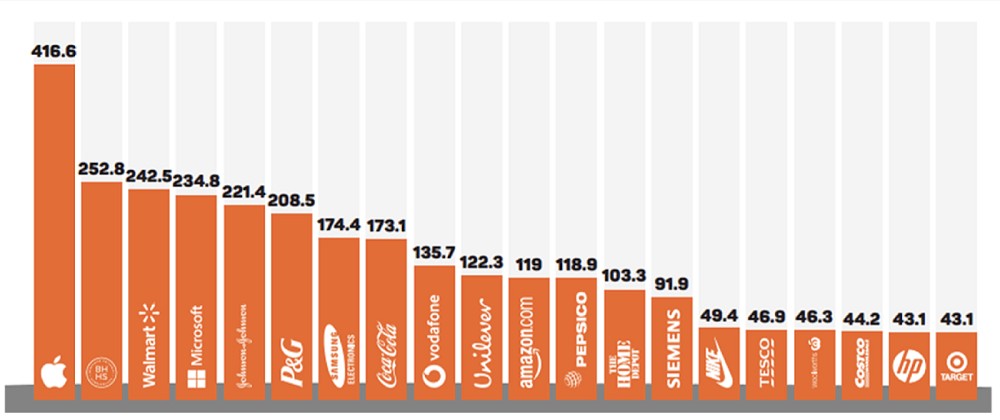Think of the largest retailer in the world, and you are likely to name Apple and Amazon first, and maybe some of the supermarkets will be top of mind too. It is now a tough sector, and successful retail stores understand how to maximise current trends and behaviours. Here we explore how the most successful retail brands in the world made it to the top and how they sustain their position.
Tech Platforms Dominates
Apple
It should come as little surprise that Apple top the table in market value, with an estimated value of $416.6 billion, more than a third more than the nearest competitor Berkshire Hathaway which owns multiple brands such as Duracell and Dairy Queen.

There are many books written about the reasons for the rise in success of Apple, and mostly about the mystique of Steve Jobs. Realistically, the radical simplicity of the branding “Think Differently”, and the intense attention to the user experience set this company apart.
Amazon
Another tech giant, Amazon, has its hand in pretty much everything. From TV and music streaming through to the online store where you can buy anything. And now, Jeff Bezos is heading out to space along with the other mega-rich.
Amazon started as a bookseller and soon became one of the world’s largest retailers due to its model as a platform between seller and buyer. It didn’t have to risk too much of an inventory, as this risk was passed onto the marketplace. While Amazon offers some products, it is grown quickly and successfully because it chose to be a distributor for other sellers.
The High Street Fight Back
While the giants might be the online tech platforms, there is still a significant demand for the high street.
Walmart
Walmart tops the table here, with $242.5 billion market value. The boost to the value of Walmart comes from smart acquisitions, as proven in 2016 with the purchase of Jet.com by the group. As well as offering convenient services in a world that wants instant gratification, Walmart has understood the need to donate to charitable causes.

Home Depot
Home Depot has made similar choices to stay relevant. They have put customer care at the centre of their ethos and so stayed ahead of competitors. Home Depot was one of the first to make use of self-checkouts and it is this constant innovation to employ the latest technology that helps them to thrive.
Tesco
While small in comparison to competitor Walmart, Tesco is still a behemoth with a value of $46.9 billion. Again, innovation is at the core of their success, as is the desire to pass on savings to the customer. They were the first organisation to introduce a points collection scheme with Green Shield Stamps, and they have not stopped looking for the next best experience for the customer.
TK Maxx
TK Maxx has changed the way we think about clothes rails. As with Apple and Amazon, retail success comes from an innovative model, changing how we view shopping. Open in 1976, TJ Maxx offers out-of-season top labels at discount prices. This proposition is not new and has been used by many. However, what is different is how they challenge the buyer to find the golden nuggets in their stock.
Avid fans of TJ Maxx know delivery day brings a whole new opportunity to find top-quality clothes at a bargain price.
Online Superpowers
Character.com
Another clothing retail success, Character.com, sells branded clothing and accessories like Harry Potter and Minecraft. The selling of items that piggyback on the cult status of another brand gives the company a long-term strategy that constantly renews itself. An endless appeal in the next Character to emerge captures the imagination of children and adults alike.
Dresden
The search for why some retail outlets succeed and others don’t tend to run on a theme. Dresden, like the other stores mentioned, has a distinct market position. Dresden is a company selling upcycled eyeglasses and sunglasses made from plastic waste and discarded fishing nets. They have this strong ethical position in terms of the environment and then choose to sell these at an affordable price.
Values-driven companies are a significant hit in the marketplace because of the demands of the younger generations for more sustainable and ethical practices. Dresden sells something beyond the idea of glasses, as they sell the idea of protecting the environment.
TheSuperCool
This gift seller has grown thanks to the power of social media and the positioning of its interesting and varied inventory on sites like Instagram and Pinterest. However, they also have values, as they are committed to supporting small businesses worldwide. They choose organic, fair trade and handmade products, mostly handmade products from family-run organisations.
The site has been recognised for its visual merchandising, making everything it sells feel like a must-have. It has also been recognised for its international retail model that gives a platform to artisans around the globe. It started as a pop-up shop in various locations around Australia and is now an international brand.
Aerie
Finally, Aerie has shown double-digit sales growth for the last 13 seasons compared to its main competitor Victoria’s Secret, which has experienced a gradual decline. Why? Well, some point to the different models used by the different organisations. Aerie uses a range of body shapes, and Victoria’s Secret sticks to the tradition of rail-thin beauties.
Summary – Success Of Retail Brands
The success of retail brands is more than just about the right product in front of the right market. Companies that succeed are those with a powerful ethos and market position and a story to tell their customers. With this narrative, clients become advocates.